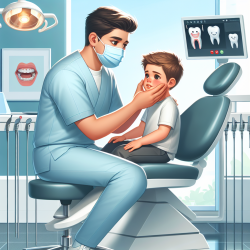Foetal Alcohol Syndrome Disorders (FASD) encompass a range of conditions resulting from prenatal alcohol exposure. These conditions can significantly impact a child's development, including their oral health. A recent study titled Orthodontic Evaluation of Children and Adolescents with Different Types of Foetal Alcohol Syndrome Disorders by Ludwików et al. (2022) provides critical insights into the orthodontic needs of children with FASD. This blog aims to help practitioners improve their skills by implementing the outcomes of this research or encouraging further research.
Understanding the Research
The study conducted by Ludwików et al. involved 67 participants aged 2.5 to 17.8 years, all diagnosed with FASD. These participants were divided into three subgroups: foetal alcohol syndrome (FAS), partial foetal alcohol syndrome (PFAS), and alcohol-related neurodevelopmental disorders (ARND). The researchers assessed general and oral health status, including the presence of malocclusion and orthodontic treatment needs, and compared these findings to a national monitoring survey on oral health conditions in Poland.
Key Findings
The study revealed several critical findings:
- Children with FASD had a higher prevalence of systemic anomalies, including alimentary, neurological, and musculoskeletal disorders.
- Dysfunctions and parafunctions such as mouth breathing and thumb sucking were more frequently recorded in children with FASD.
- Increased prevalence of distal occlusion and crossbite compared to the general population.
- Malocclusions were more often identified in the FAS group.
- No significant differences in the Index of Orthodontic Treatment Need (IOTN) between different FASD groups were found.
- Borderline need for orthodontic treatment was more frequent in children with FASD compared to controls.
Implications for Practitioners
These findings have significant implications for practitioners working with children diagnosed with FASD. Here are some practical steps you can take to improve outcomes for these children:
1. Early Screening and Diagnosis
Early screening for dysfunctions, parafunctions, and malocclusions in children with FASD is crucial. Identifying these issues early allows for timely intervention, which can prevent more severe problems later on.
2. Implement Orthodontic Prophylaxis
Orthodontic prophylaxis involves preventive measures to avoid the development of malocclusions. This can include educating parents and caregivers about the importance of maintaining good oral hygiene and addressing habits such as thumb sucking and mouth breathing.
3. Advocate for State-Funded Orthodontic Care Programs
Given the increased need for orthodontic treatment in children with FASD, advocating for state-funded orthodontic care programs can help ensure these children receive the necessary treatment without financial burden on their families.
4. Continuous Education and Research
Staying updated with the latest research and continuing education in the field of orthodontics and FASD can help practitioners provide the best care possible. Encouraging further research in this area can also lead to better understanding and treatment options for children with FASD.
Conclusion
The study by Ludwików et al. highlights the critical need for early screening, preventive measures, and accessible orthodontic care for children with FASD. By implementing these recommendations, practitioners can significantly improve the oral health and overall well-being of these children.
To read the original research paper, please follow this link: Orthodontic evaluation of children and adolescents with different types of Foetal Alcohol Syndrome Disorders.










